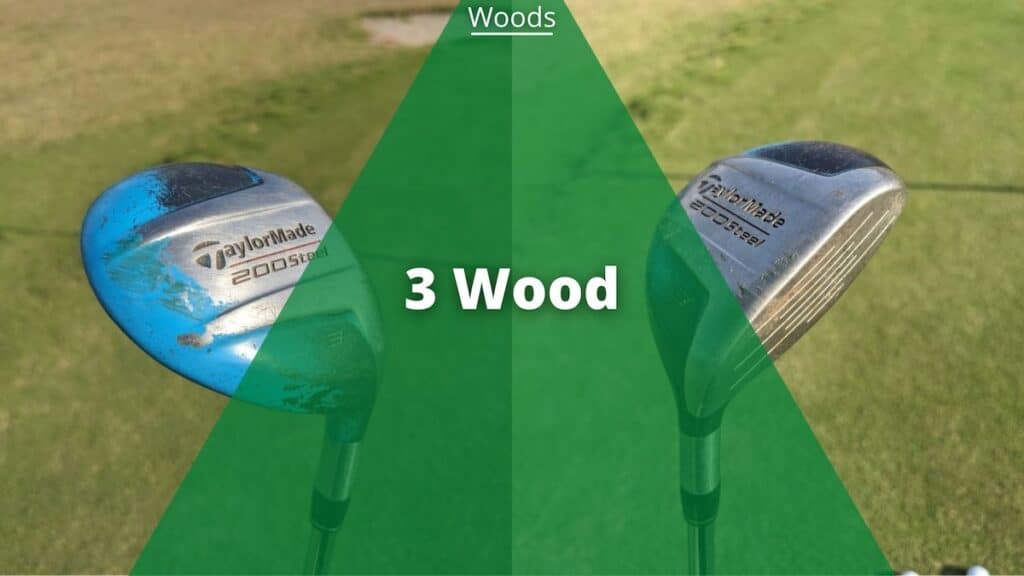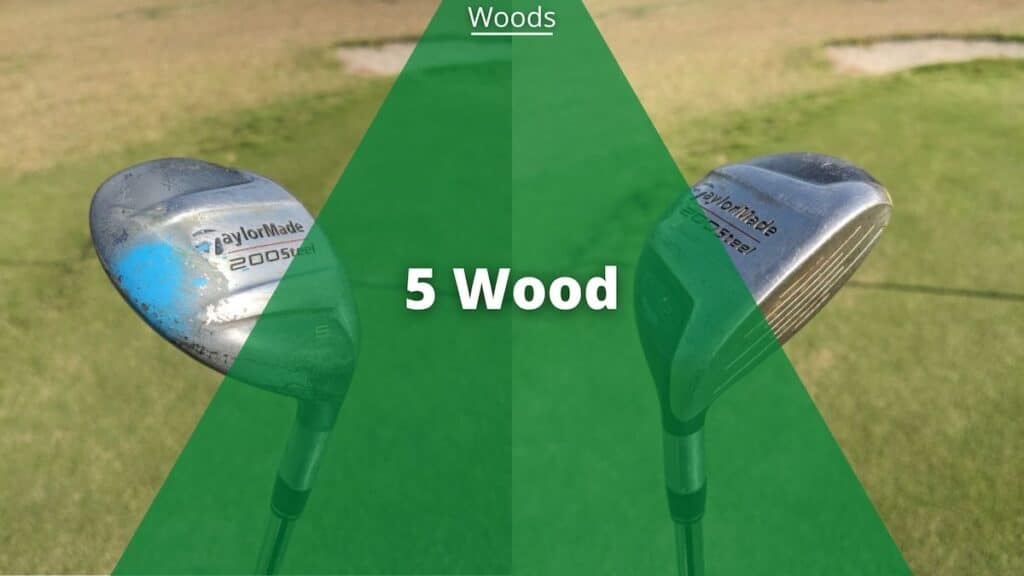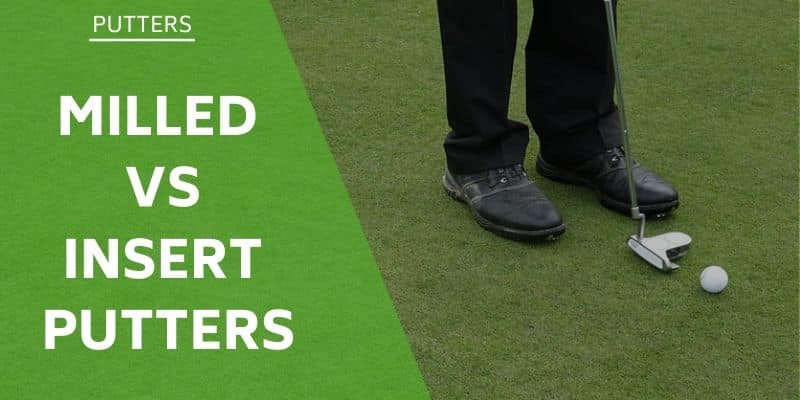The 5-wood is better for new golfers and high-handicappers because of the added loft, forgiveness, and versatility. Yet, if you’re just looking for distance, the 3-wood is the more popular choice.
You only have 14 clubs in your bag, so you won’t want to spend good money on a club you’ll never use. Or worse, a club that could hurt your scores, so be sure to read the full post.
I often tell my students to try a 5-wood since its forgiveness makes it more helpful, yet most golfers go with a 3-wood. Below you can see which is best for you.
3 Wood vs 5 Wood: Differences
| 3 Wood | 5 Wood | |
| Off The Tee | ★★★★☆ | ★★★☆☆ |
| Fairway | ★★★☆☆ | ★★★★☆ |
| Rough | ★☆☆☆☆ | ★★★☆☆ |
- The 5-wood has a smaller head and increased loft, which helps you escape the rough. I tested the 5-wood from various depths of rough, and it worked well, maintaining clubhead speed throughout impact.
- The 3-wood out of the rough is almost useless and should not be attempted unless you encounter an exceptionally good lie or have more than the standard 15 degrees of loft.
Of course, distance was still affected on the 5-wood due to the grass slowing down the club head, but not as much as with the 3-wood. This makes the 5-wood a great option for long approach shots.
Off the Tee
A well-struck 3-wood will travel much farther than a well-struck 5-wood on any shot, whether off the tee or from the deck. Tying the ball up will make it easier to make good contact even if you hit it on the up, leaving you a shorter approach shot.
Every golfer wants a shorter shot into the green. So, if it is the distance you need off the tee, your 3-wood could be a much better choice.
Off the Fairway
Both can be used off the fairway, but regarding forgiveness, the 5-wood is the clear-cut winner for any skill level.
More loft and a smaller head make this a great golf club to operate out of the fairway. It won’t go as far as your 3 wood, but the added loft will help you hold greens better instead of one-hopping over the back, which is typical with a 3 wood.
From the Rough
There’s a clear winner if you’re looking for a club to save you from the long stuff. Choose a 5-wood to attack a long par 4 without hitting the fairway. This will help high handicaps save bogey more often and turn them into mid-handicappers a lot sooner.
3 Wood: Pros & Cons

3 woods are best used for tee shots due to their longer shaft length. Mid-low handicappers will benefit most from them, but they will also experience these pros and cons.
Pros
- More distance
- Lower ball flight
- Reach more par 5s in two
- Easy to hit off the tee
- Easy to shot shape
- Could replace driver
Cons
- Less forgiving with off-center hits
- Hard to hold greens
- Challenging for mid-high handicappers to hit off the deck
Pro Tip: Before throwing your 3 wood in the garbage, take it to a club fitter and ask them for a shorter shaft length. Either a 1/4″ or a 1/2″ under standard should do it; the more you cut off, the more control you’ll gain, but the more club head speed you’ll give up. Never cut more than 1″; any shorter, and it will make more sense to switch to a 5 wood.
Who Is the 3 Wood For?
Because of its longer shaft and low loft, many golfers don’t use the 3 wood on a fairway. They can prove difficult to use properly in the beginning. However, most will use the 3 wood when the driver would send the ball too far. They have a similar but a smaller clubhead than a driver. The other reason that you would use it is to hit the 5 par in 2.
5 Wood: Pros & Cons

A 5 wood is great for high handicap golfers to get a higher ball flight on longer shots from various lies. They are common with 19 degrees of loft but opt for 20-22 degrees for more height.
Pros
- High forgiveness
- Easy to hit from the rough
- Provides softer landing into greens
- More accuracy from tee and fairway
- Useful on long par-3s
Cons
- Not great off a tee
- Hard to shape shots
- Lacks distance
Pro Tip: If you’re confident with a 5-wood but unsure about leaping a 3-wood, customize your 5-wood with a stronger loft. This will provide a low spin without taking too much forgiveness away. Don’t go too low on the loft; otherwise, you’ll lose stopping power on the greens.
Who Is the 5 Wood For?
In most cases, you pull out a 5 wood club when you can reach the green from the fairway. Because of its shorter shaft length and a higher loft, most golfers find them easier to use. The loft would mark the biggest difference between the 3 wood and the 5 wood. You can also use it from the semi-rough.
Fairway Woods vs Hybrids
Hybrids are better suited to replace your long iron than your fairway woods, but some opt to replace their 5-wood with a 3 hybrid and forgo their 3-iron. The 3 hybrid offers even more forgiveness than a 5 wood and is easier to hit out of various lies.
I recommend avoiding the 3-wood for new golfers until you become comfortable with a 5-wood or at least the 3 hybrid. These are great training aids that will make you better with fairway woods before you even pick one up.
I’ve been using a 3 hybrid instead of a 5-wood and even a 3 wood because of how easy it is to hit and its versatility. But if you have a slower swing speed, this may not work for you, and carrying a 3 hybrid and 3 wood would be better suited.
Related Articles
- The 3 Wood vs 3 Hybrid
- The Best Fairway Woods For High Handicappers
- How To Hit A Fairway Wood
- Driver Mistakes To Avoid
FAQs
Does a 3 Wood Hit Farther Than a 5 Wood?
You will struggle to use the 3 wood as an amateur golfer, but you can expect to hit the ball around 20 yards farther. Later, as you improve, a 3 wood will hit the ball much farther than a 5-wood, but in the beginning, you may even find how a 5-wood offers you better consistency for distance.
Is It Easier To Hit a 3 Wood or a 5 Wood?
Without a doubt, the 3 wood will take a longer time to learn than the 5 wood. The 5 wood has a much easier design that the average golfer will struggle less with learning how to use.
Clint is PGA-certified and was a Head Teaching Professional at one of Toronto's busiest golf academies. He was also featured on Canada's National Golf TV program, "Score Golf Canada," twice. He graduated with a degree in Golf Management from the College of the Desert in California and studied under Callaway's co-founder, Tony Manzoni. He has a handicap index of 6.2 and spends the winters near Oaxaca, Mexico, where he plays twice a month at the Club de Golf Vista Hermosa. He's written over 100 articles at GolfSpan since 2021. You can connect with Clint at LinkedIn, FB, his website, or Clintcpga@gmail.com.







